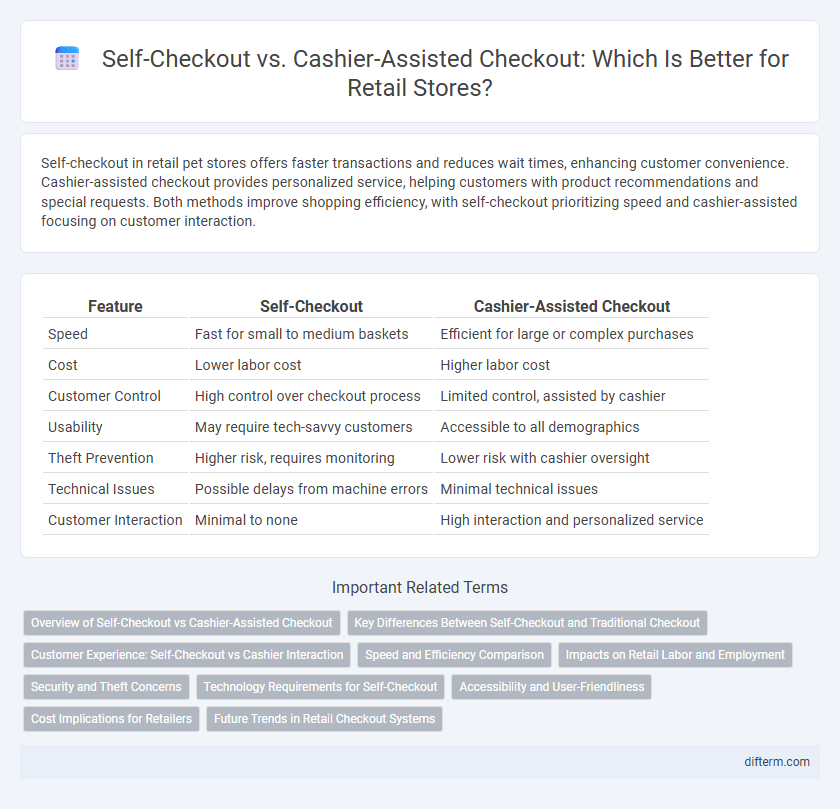Self-checkout in retail pet stores offers faster transactions and reduces wait times, enhancing customer convenience. Cashier-assisted checkout provides personalized service, helping customers with product recommendations and special requests. Both methods improve shopping efficiency, with self-checkout prioritizing speed and cashier-assisted focusing on customer interaction.
Table of Comparison
| Feature | Self-Checkout | Cashier-Assisted Checkout |
|---|---|---|
| Speed | Fast for small to medium baskets | Efficient for large or complex purchases |
| Cost | Lower labor cost | Higher labor cost |
| Customer Control | High control over checkout process | Limited control, assisted by cashier |
| Usability | May require tech-savvy customers | Accessible to all demographics |
| Theft Prevention | Higher risk, requires monitoring | Lower risk with cashier oversight |
| Technical Issues | Possible delays from machine errors | Minimal technical issues |
| Customer Interaction | Minimal to none | High interaction and personalized service |
Overview of Self-Checkout vs Cashier-Assisted Checkout
Self-checkout systems enable customers to scan, bag, and pay for items independently, reducing wait times and increasing efficiency in retail environments. Cashier-assisted checkout provides personalized service, helping with complex transactions and fostering customer interaction. Retailers must balance technology adoption with customer preferences to optimize operational flow and satisfaction.
Key Differences Between Self-Checkout and Traditional Checkout
Self-checkout systems allow customers to scan and pay for items independently using touchscreen interfaces and barcode scanners, reducing labor costs and wait times. Traditional cashier-assisted checkout provides personalized service, enabling cashiers to handle complex transactions, offer product recommendations, and manage customer inquiries. Retailers must balance efficiency and customer experience when choosing between self-checkout technology and cashier-assisted lanes.
Customer Experience: Self-Checkout vs Cashier Interaction
Self-checkout systems enhance customer experience by offering speed and control, reducing wait times and empowering shoppers with privacy during transactions. Cashier-assisted checkout provides personalized interaction, aiding customers needing assistance and fostering a human connection that can improve satisfaction and loyalty. Retailers must balance technology and human touch to optimize the checkout experience based on shopper preferences and store environments.
Speed and Efficiency Comparison
Self-checkout systems significantly reduce wait times by allowing multiple customers to scan and pay simultaneously, enhancing overall store throughput. Cashier-assisted checkouts typically involve longer transaction times due to human processing and potential error handling. Retailers aiming for maximum speed and operational efficiency often prioritize self-checkout solutions to streamline customer flow and minimize bottlenecks during peak shopping hours.
Impacts on Retail Labor and Employment
Self-checkout systems reduce the demand for traditional cashier roles, leading to a shift in retail workforce composition towards more technical and customer service positions. The automation of transactional tasks often results in fewer full-time cashier jobs but increases opportunities for employees managing machine maintenance and customer assistance. Retailers balancing self-checkout with cashier-assisted options can optimize labor costs while addressing diverse customer preferences and employment needs.
Security and Theft Concerns
Self-checkout systems increase the risk of theft due to limited employee oversight, making it easier for shoplifting and barcode manipulation to occur. Cashier-assisted checkouts provide enhanced security through direct supervision and controlled scanning processes, reducing shrinkage and fraud. Implementing advanced surveillance technology and AI-powered monitoring can mitigate security vulnerabilities in both checkout methods.
Technology Requirements for Self-Checkout
Self-checkout technology requires robust hardware components such as barcode scanners, RFID readers, and touch-screen interfaces to ensure fast and accurate item processing. Software solutions must integrate with inventory management systems and support secure payment gateways, including contactless and mobile wallets, to enhance transaction speed and security. Real-time monitoring and AI-powered loss prevention tools are essential to detect and reduce theft, ensuring operational efficiency within retail environments.
Accessibility and User-Friendliness
Self-checkout systems enhance accessibility by allowing users with varying physical abilities to control the speed and manner of their transaction, supporting features like touchscreens with adjustable heights and voice guidance for visually impaired customers. Cashier-assisted checkout offers personalized support, which benefits users unfamiliar with technology or those needing assistance due to disabilities, ensuring a smoother experience. Retailers must balance self-checkout's independence with the empathetic assistance of cashiers to optimize overall user-friendliness and accessibility.
Cost Implications for Retailers
Self-checkout systems reduce labor costs significantly by minimizing the need for cashier staff, leading to lower operational expenses for retailers. Initial investments in self-checkout technology and ongoing maintenance can be offset by increased transaction speed and higher customer throughput. However, potential costs related to theft prevention and system downtime should be carefully managed to preserve overall profitability.
Future Trends in Retail Checkout Systems
Self-checkout systems are increasingly integrating AI and computer vision technologies to enhance speed and reduce errors, signaling a major shift toward automation in retail checkout experiences. Retailers are investing in contactless payment options and mobile wallet integrations to meet consumer demand for convenience and safety. Cashier-assisted checkout will evolve to incorporate digital tools that support personalized service, blending human interaction with technology for a seamless shopping experience.
self-checkout vs cashier-assisted checkout Infographic

 difterm.com
difterm.com